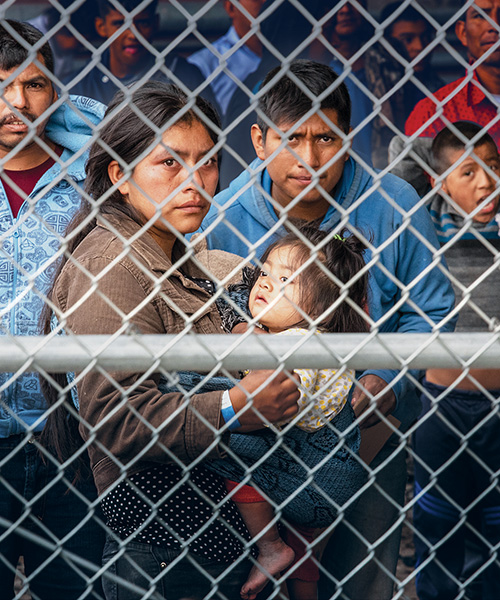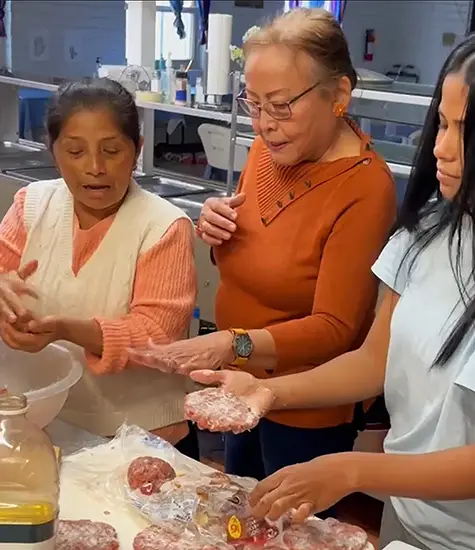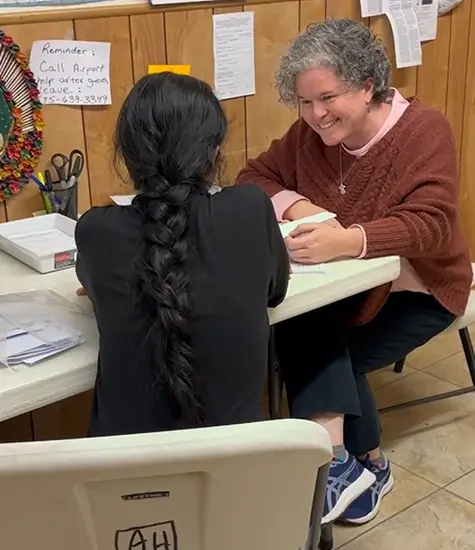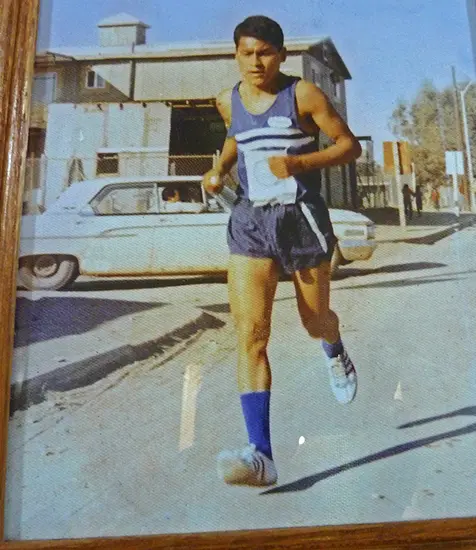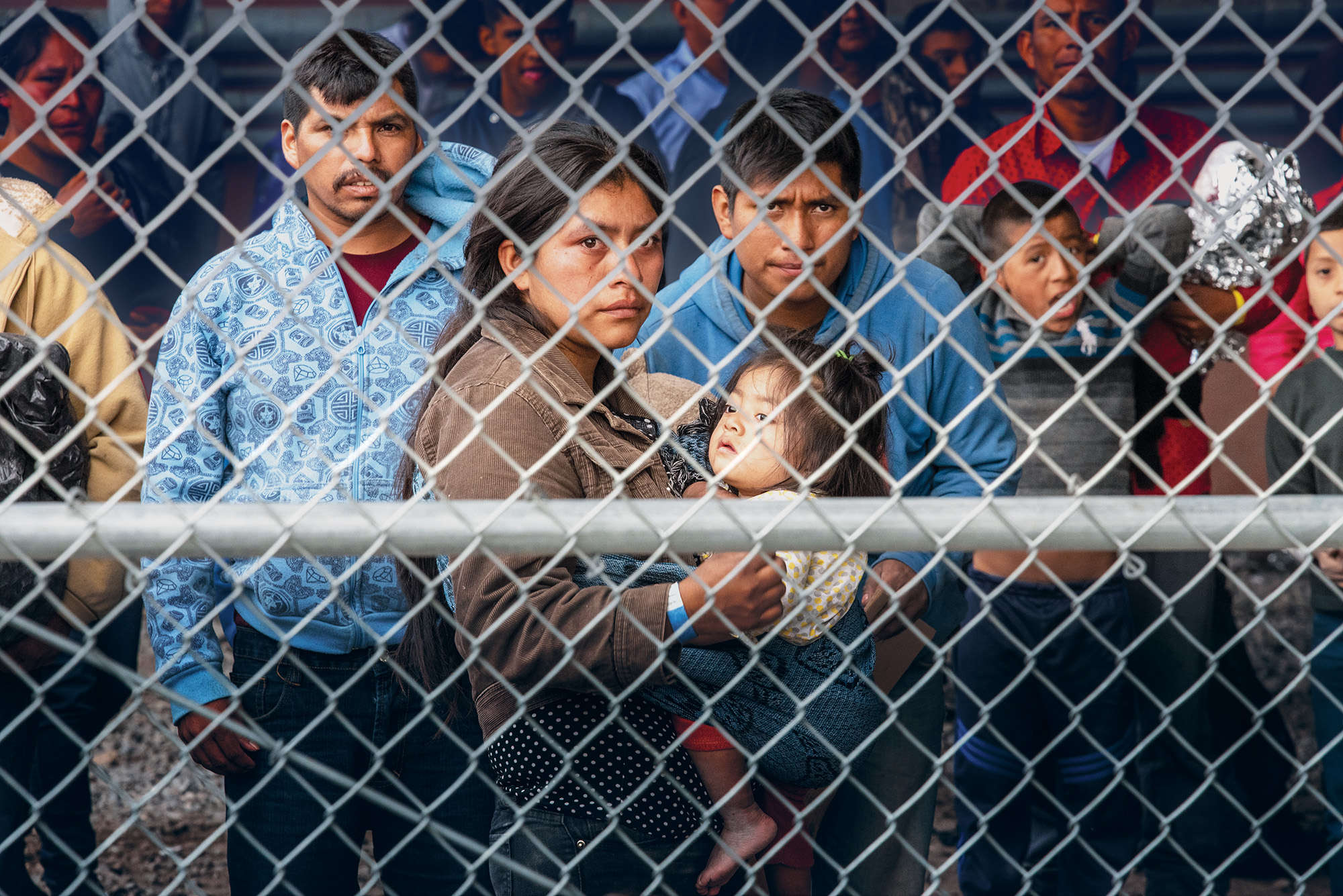
In late March migrants are gathered inside the fence of a makeshift detention center in El Paso, Texas. Photo by Sergio Flores
At the start of this year, Maryknoll lay missioner Heidi Cerneka moved to El Paso, Texas, to begin a new ministry as an immigration attorney at the U.S. Mexico border.
One of the people she met was Zam Babirye, a woman from Uganda whose work advocating for youth had landed her in trouble with the Ugandan government. “I was beaten, I was imprisoned, I was raped,” says Zam. The persecution also resulted in the death of two family members—her sister and her brother-in-law. The two were killed, Zam says, while using her car to drive to a funeral. The hit had been meant for her.
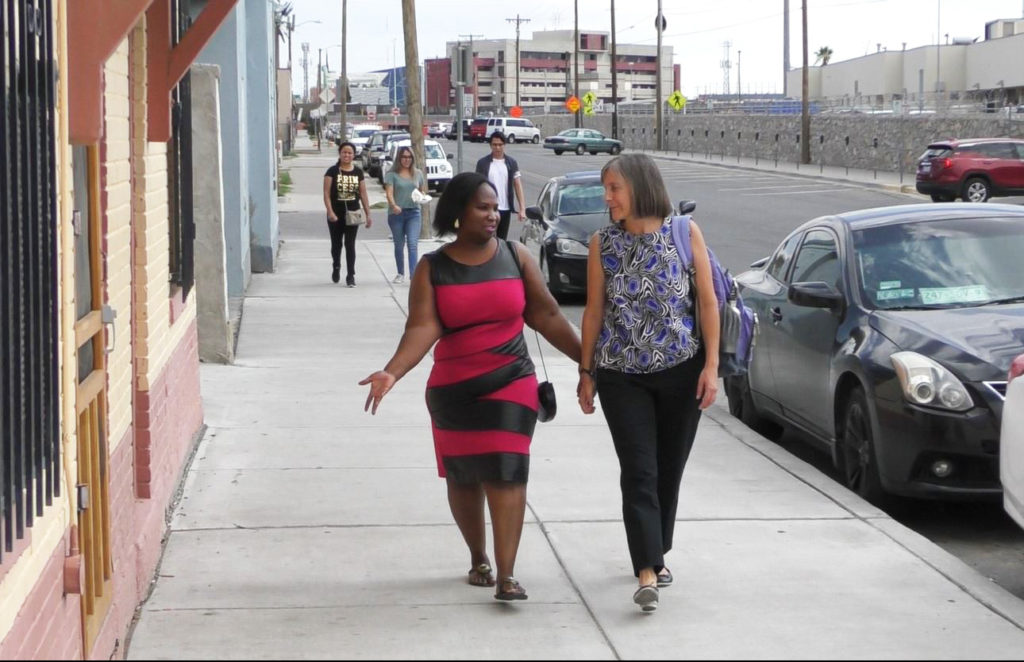
In downtown El Paso, Heidi accompanies Zam Babirye, an immigrant from Uganda whose asylum case Heidi won, on her way to buying a bus ticket to Los Angeles.
It was at that point that Zam decided to flee for her life. She left her children in her mother’s care and eventually made her way to the U.S., seeking asylum, and planning to bring her children once she had it.
Like other asylum seekers, Zam came to the U.S. to exercise her right to seek protection under UN and U.S. refugee and asylum laws. The U.S. signed and ratified the U.N. Convention on Refugees as well as a U.S. law that declare that people fleeing persecution have the right to seek refuge in this country. But once they arrive in the U.S., our law requires asylum seekers to prove in immigration court that they meet the narrow requirements that allow them to remain in the country.
That is where Heidi comes in. Heidi works as a pro bono immigration attorney at Las Americas Immigrant Advocacy Center, an El Paso-based nonprofit organization that provides free and low-cost legal services to immigrants and refugees. Heidi took on Zam’s case as her attorney, representing her in her claim for asylum in court.
Eventually, through the representation of Heidi and the Las Americas Immigrant Advocacy Center, Zam won her case and was granted asylum in the U.S. She was released, and Heidi helped arrange for her stay at Villa Maria, a temporary home for women in El Paso.
“Winning asylum is a road to a new life,” Heidi says. Zam will not only be able to stay in the U.S., but now that she has been granted asylum herself, she will be able to apply to bring her children to join her in safety. When Zam was ready to move on from El Paso, Heidi helped her to relocate to the Los Angeles area by putting her in touch with the Maryknoll Sisters in Monrovia, who welcomed her there in August.
Winning cases like Zam’s is not easy. While nationwide about a third of asylum cases are granted, the El Paso immigration courts are granting only 3 to 7 percent of asylum seekers permission to stay in the U.S.
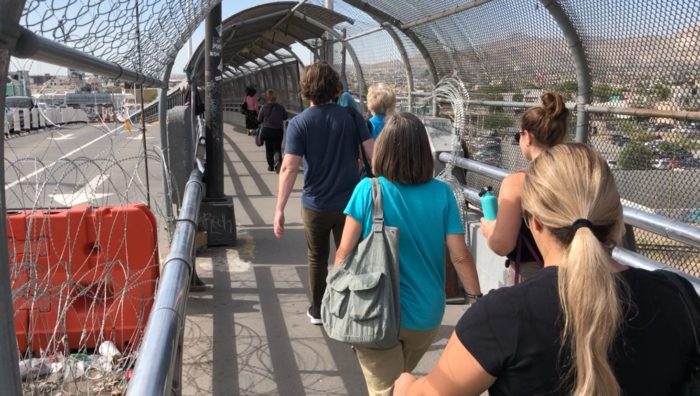
Heidi and a fellow attorney from the Las Americas Immigrant Advocacy Center are leading a group of legal aid volunteers across the border for intake interviews at shelters in Ciudad Juárez, Mexico.
More recently, things have become even more difficult because of the endless stream of new policies and regulations that the U.S. government has issued this year. In fact, since she arrived in El Paso, Heidi says that the one constant of U.S. policy on immigration has been that it is constantly changing.
Two new U.S. policies—the Migrant Protection Protocols, better known as the “remain-in-Mexico” policy, and the “metering” program—have now forced many migrants and asylum seekers who arrived at the El Paso border into the streets of Ciudad Juárez on the Mexican side.
The remain-in-Mexico policy sends asylum seekers who speak Spanish back over the border, requiring them to remain in Mexico for the duration of their legal proceedings. And the metering program, in direct contradiction of UN protocols, denies asylum seekers the ability to even reach U.S. soil to apply for asylum. They are forced to return to Mexico and directed to place their name on a waitlist and wait for their number to be called.
As a result of these two policies, Heidi is now working on both sides of the border.
By early August, these policies had forced some 19,000 asylum seekers at the El Paso entry points back across the border into Ciudad Juárez. There, many are stuck living in the streets, where they are at the mercy of gangs and others who have found easy prey among the vulnerable foreigners. Mexican churches and community organizations are doing what they can to help the sudden influx of migrants, but shelters are overcrowded and resources are limited.
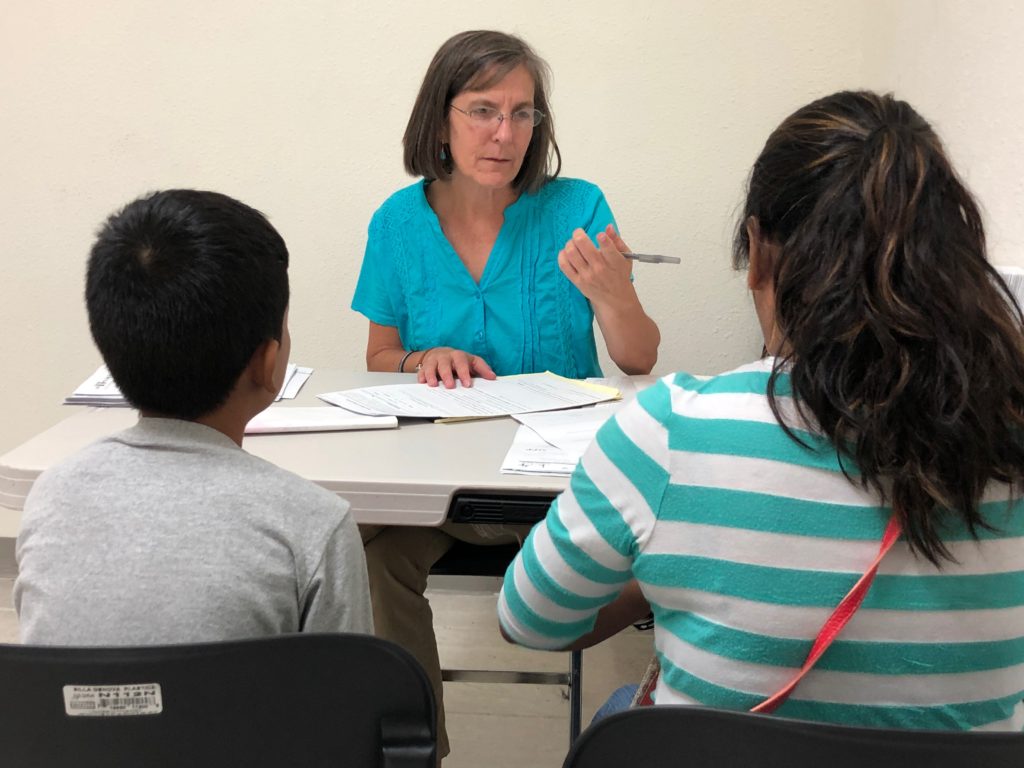
During an intake interview in Ciudad Juárez, Heidi talks with a woman and her son, who fled Guatemala because of gang extortion and domestic violence.
On a recent day of intake interviews at two shelters in Ciudad Juárez, Heidi listened to asylum seekers from Guatemala, Cuba and El Salvador. The stories she heard were heartbreaking—threats from gangs, brutal domestic violence, robberies, kidnapping, extortion, rapes and being a witness to a double murder. But at the end of the day, given the current restrictions on asylum, despite clear cases of persecution in their home countries, none of the people were likely to be successful with their applications.
On her way back from Juárez to El Paso, Heidi points out the two guards stationed on the Paso del Norte Bridge, whose job it is to enforce the “metering” program by preventing potential asylum seekers from entering the U.S.
“Those who put their names on the waitlist have to wait at least six months in Mexico to even voice their asylum claim,” Heidi says, “and then begin the immigration court process, which will likely take another four months or more.” During all that time, they may be on the streets or in a shelter, with no resources and no work opportunities. And when their number is finally called, they will most likely have to be their own “attorney,” which is practically a guarantee that their claim will be rejected.
Meanwhile, during her visits to immigrant detention centers on the U.S. side, in and near El Paso, Heidi has witnessed how migrants are separated from their family members and their children. “Their only ‘crime’ is having the courage to flee violence in their home countries and exercise their right to ask for asylum,” she explains. “They are kept weeks without a shower and packed into overcrowded detention facilities with no access to immigration attorneys or legal assistance.”
The part U.S. policy plays in the humanitarian crisis at the border is especially difficult for Heidi. She sees policies like the metering system as an “erosion of our nation’s values,” and she believes that “the damage to human beings and to the integrity of the U.S. is irreversible.”
It is also discouraging that with such large numbers of asylum seekers, Heidi and the others involved in this work cannot help everyone. “Every day, we hear all these stories from so many people whom we can’t help,” Heidi reports. “Many times we feel so powerless to do anything about that. There’s this messy mix of anger and sadness and powerlessness. That is very challenging.”
Fortunately, there are successes along the way that help her keep going. In addition to the case with Zam, Heidi recently won two “withholding of removal” cases—one for a Cuban political asylum seeker and one for a lesbian woman from Guatemala. For both, although they are not officially being granted asylum, the judge has recognized that their lives will be at risk if they are sent home and has ruled they can remain legally in the U.S.
These successes demonstrate the importance of having missioners like Heidi working at the border.
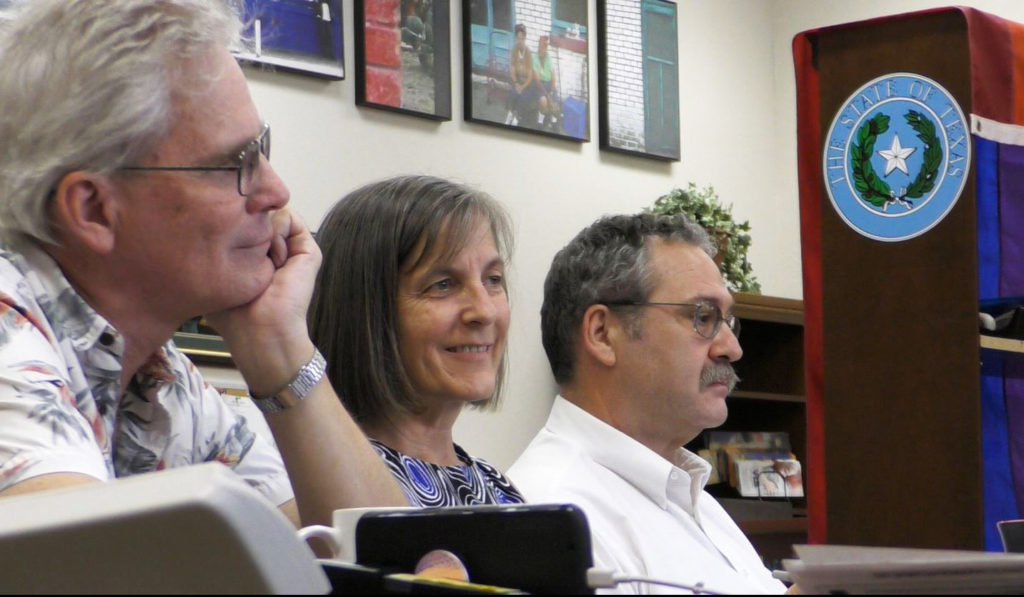
Heidi representing Las Americas Immigrant Advocacy Center during a coordination meeting of El Paso
community and church groups on immigration-related issues. The twice-monthly meeting is organized by Texas State Rep. José Rodríguez and held in his El Paso office.
In addition to her legal work, Heidi has also been helping with the advocacy role Las Americas plays both in the El Paso community and on the national scene. For example, she has served as a liaison for lawmakers to better inform them about the situation on the border. And she has given educational talks about the border reality in Chicago, Boston, New York and Washington.
Linda Corchado, the director of legal services, to whom Heidi reports at Las Americas Immigrant Advocacy Center, says that Heidi’s “work has just been indispensable. She’s just so passionate. Going to the detention facilities and to Ciudad Juárez, she is experiencing how asylum seekers, who are some of the most vulnerable people on earth, are being rejected by our country, how they’re being treated badly in detention facilities.”
Marj Humphrey, Maryknoll Lay Missioners’ director of mission, who recently visited Heidi’s ministry at the border, concurs that “Heidi’s work is nothing short of remarkable. In the midst of incredible suffering, and overwhelming needs, I encountered a human response—one person at a time—that offers palpable hope to so many migrants.”
Marj also points out that in addition to working long hours as an immigration lawyer, Heidi lives at and participates in the Encuentro Project in El Paso. This collaborative project coordinated by several religious congregations combines border immersion and service experiences with education and reflection on the daily reality and the seemingly endless obstacles that migrants face in their desperate hope for asylum.
“I was inspired,” Marj says, “by the large numbers of young people who take time out to come to the border, eager to learn about the situation and what they could do in the face of this crisis of mass migration.”
She adds, “Being able to put human faces to the news reports made it all the more imperative to me that each of us must act, must do what we can, no matter how near or far from the situation.”
Heidi agrees, saying, “As people of faith, we have an absolute responsibility to look at our neighbor and ask ourselves, ‘What does that person need to live a safe, healthy and just life? And what do I—and we as a community—need to do to make that happen?’” She adds, “There’s a million ways to do that. Prayer is essential, but we have to do a lot more than prayer. Absolutely, God gives us these hands for a reason.”
One way you can help
Maryknoll Lay Missioners is planning to expand its ministry on both sides of the U.S.-Mexico border. Veteran missioner Coralis Salvador will be joining Heidi at the beginning of 2020, and the hope is that others will follow as well.
Please support Heidi’s work and help us to make additional border ministries possible by donating to our border fund here.
Thank you for your generous support!
This is the cover story of the Fall-Winter 2019 issue of Voices of Compassion.
Top photo by Sergio Flores. All other photos by Meinrad Scherer-Emunds
For more on Heidi’s ministry, watch this video and visit this web page.

